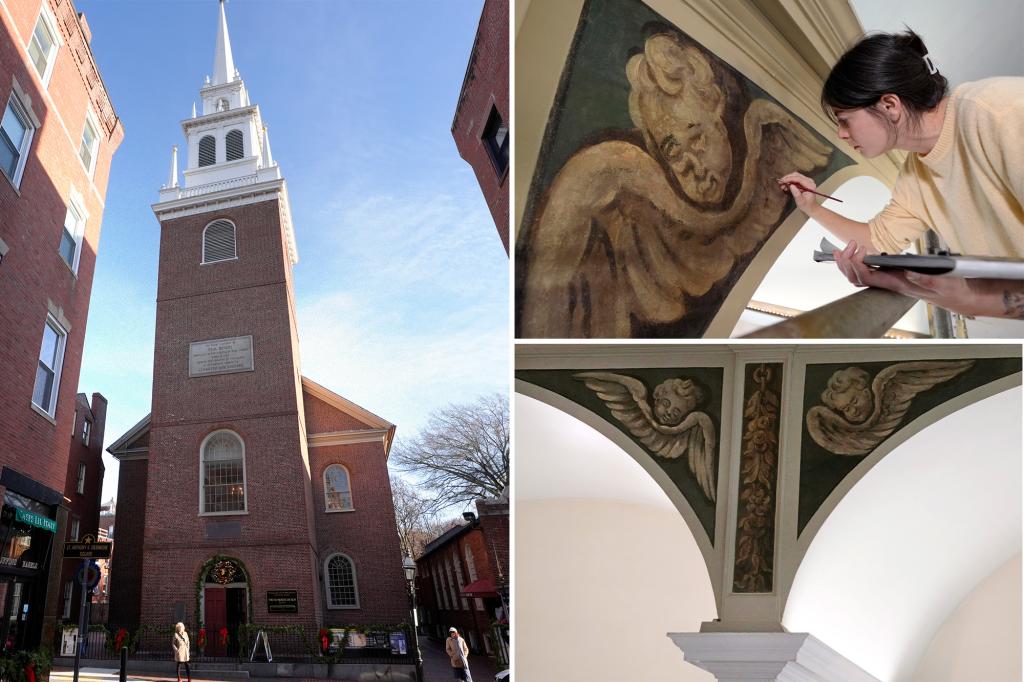The Old North Church in Boston, renowned for its connection to Paul Revere’s midnight ride, is undergoing a remarkable transformation as conservators meticulously unveil a hidden treasure: twenty angelic figures, obscured for over a century beneath layers of paint. These cherubic forms, with their rounded features and outstretched wings, were originally painted around 1730 by John Gibbs, a member of the church’s congregation. They served as a defining characteristic of the church’s interior, contributing to the vibrant and colorful atmosphere experienced by early worshippers. However, in 1912, these angelic figures were inexplicably covered by thick coats of white paint, effectively erasing them from the church’s visible history. Now, just months before the 250th anniversary of Revere’s famous ride, these angels are being painstakingly brought back to light, offering a glimpse into the church’s rich and complex past.
The rediscovery and restoration of these angels is a significant event for the Old North Church, adding another layer to its historical narrative. The church, a popular tourist destination in Boston’s North End, is often associated primarily with Revere’s ride and the iconic lanterns signaling the British army’s approach. However, the church’s history extends far beyond this singular event. Founded in 1723, the Old North Church served as a vital center for Boston’s growing Anglican community, reflecting the city’s evolving religious landscape. The church’s early history is also intertwined with the darker aspects of colonial America, including the involvement of some of its members in the slave trade. The restoration of the angels provides an opportunity to delve deeper into the church’s multifaceted past, exploring both its triumphs and its complexities.
The restoration process itself is a delicate and intricate endeavor, requiring both artistic skill and historical sensitivity. Conservators Gianfranco Pocobene and Corrine Long have been working tirelessly to uncover the angels, carefully removing layers of paint accumulated over more than a century. The team employs a combination of techniques, including solvent gels and plastic scrapers, to gently peel back the layers of paint without damaging the underlying artwork. Cotton swabs are used for cleaning, and retouching is done sparingly to address any damage sustained over the years. The painstaking nature of this work underscores the commitment to preserving the angels’ original appearance and artistic integrity.
Each angel, individually painted by John Gibbs, possesses a unique character and pose, creating a rhythmic pattern across the church walls. This artistic variation adds to the historical significance of the angels, highlighting the craftsmanship and personal touch of the original artist. The rediscovery of these figures allows modern visitors to experience the church as it would have appeared to early congregants, offering a tangible connection to the past. The vibrant colors and artistic detail of the angels would have undoubtedly contributed to the overall atmosphere of worship, creating a visually stimulating and spiritually enriching environment.
The restoration of the angels is not merely a cosmetic enhancement but a symbolic act of reclaiming the church’s history. The removal of the white paint reveals more than just artistic figures; it uncovers a forgotten layer of the church’s identity. The colorful interior, once obscured, is now being brought back to life, offering a glimpse into the aesthetic and spiritual sensibilities of the early Anglican community. This restoration project coincides with the upcoming 250th anniversary of Paul Revere’s ride, prompting a broader reflection on the church’s significance and its multifaceted role in American history.
The unveiling of the angels serves as a powerful reminder of the importance of historical preservation. By meticulously restoring these hidden artworks, conservators are not only preserving the physical artifacts but also reviving the stories and traditions they represent. The angels, once hidden from view, now stand as testaments to the church’s enduring legacy and the enduring power of art to connect us to the past. The restoration project is an ongoing process, with more angels expected to be revealed in the coming months. As each angel emerges from beneath the layers of paint, it offers a renewed appreciation for the artistry and history of the Old North Church, enriching our understanding of this iconic landmark and its place in the American narrative.

